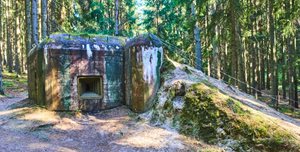The protection of the state border was considered from the time Czechoslovakia was founded. When Adolf Hitler became the Chancellor in neighbouring Germany in 1933, the need to protect the country and its borders intensified. A fortified system, unparalleled in its sophistication in Europe, was built within a few years, but not only along the border. The backbone of the protection of the Czechoslovak Republic was formed by heavy fortification where a garrison of hundreds of men was considered. The construction of about twelve fortresses and forts as such was completed or started, and you can now visit some of them. If you are a fan of military history, do not hesitate – it’s worth it!
1. Hanička Fortress
Where: North of Rokytnice in the Orlické Mountains, East BohemiaHanička is an artillery fortress that consisted of six combat objects under the ground, connected with passages and hallways hundreds of metres long. These were to be used for storage, which would allow the garrison to fight for several months in case of siege. Today, you can see the weapons used by the Czechoslovak Army in 1938 and after WWII. The museum also includes a small collection of ammunition and uniforms from both periods of Czech history. There are also barracks and offices, a water treatment plant, a medical dispensary, the dining room and a sanitary facility.
The fortress was built between 1936 and 1938 as part of the Czechoslovak fortification, and the crew included 426 men. In the mid-70s, the secret reconstruction of Hanička as a fallout shelter started.
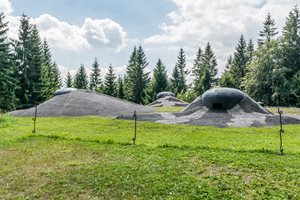
2. Dobrošov Fortress
Where: Near Náchod in East BohemiaThis fortress was never completed. The tours today lead from the artillery blockhouse through the ammunition depot via an additionally reinforced passage of the main gallery, barrack halls, the medical dispensary to the next blockhouse. The underground fortress has collapsed in several places and is not passable. Another interesting fact about the fortress is that in 1943 the tests of one of the secret weapons of the Third Reich, the Röchling missile, was conducted under strict security measures. The missile could break through 2.5 metre-thick reinforced concrete with a direct hit. In Dobrošov, Object N-S 72 Bridge was bombarded with direct fire from a distance of 300 metres. A Röchling projectile was found in its ruins in 1984 and it is now displayed in the operating area hall.
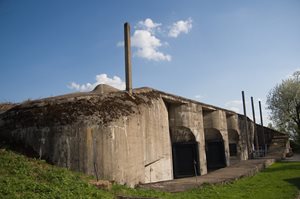
3. Stachelberg Fortress
Where: South of Žacléř in KrkonošeThe Stachelberg underground is a completely unique system – there are 3.5 kilometres of underground passages and halls at a depth of 25 to 60 meters under the ground. A garrison of 778 men was planned for the fortress. In the case of a complete siege and continuous battle, they could withstand the enemy for up to two months – that is how long the supplies of ammunition, food, fuel and other equipment was calculated for. The fortress has never been completed and it is now the seat of the Military History Museum. There is also a very unique bunker there: it is one of the three largest infantry blockhouses in the Czechoslovak fortification construction, with a concrete building volume of 3,177m3! The Museum has a collection of infantry weapons and models of fortified objects. The highlight of the tour is an 8 x 2.5 metres plastic table showing the finished Stachelberg artillery fortress.
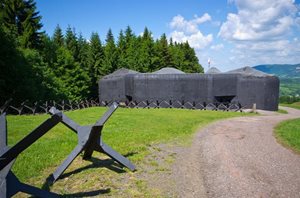
4. Hůrka Fortress
Where: Northeast of Králíky in East BohemiaThe Hůrka artillery fortress is one of the five finished fortresses in the Czech Republic, built within the Czechoslovak fortification line against Germany. Hůrka is a compound of five objects at the highest level of resistance that are connected with a vast system of passages and halls deep underground, in the total length of 1.75 kilometres. The combat objects of the fortress were completely safe against the effects of all weapons known at that time. Today, it is the best accessible large modern fortress in the Czech Republic that you can see year-round. There are some unique exhibits there, including the original sliding armoured gate at the entrance, a functional inclined elevator – a slope road, and an engine with narrow-gauge carriages. Various expositions and exhibitions are prepared in the underground fortress. The new exposition, With a Parachute above Your Head, is dedicated to the Czechoslovak parachutists who fought in WWII. This exposition is the only one of its kind in the Czech Republic.
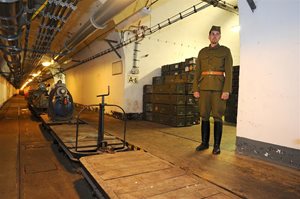
5. Slavonice Fortification Complex
Where: 2 kilometres west of SlavoniceIf you would like to see the fortification line as it looked in September 1938, go to South Bohemia. Just past Jindřichův Hradec, about 2 kilometres west of Slavonice, there is a defence fortification line formed by a system of observation and firing corridors, antipersonnel and antitank obstacles in the length of almost 200 metres. There are also 11 bunkers, reconstructed in the condition from the mobilisation period in September 1938. You can tour two fully equipped and armed bunkers, each from a different time period: one from 1938, the other from 1963. There are original machine guns, rifles, pistols and submachine guns, a functional manual ventilator and observation periscopes, gear for the crew and other equipment.
